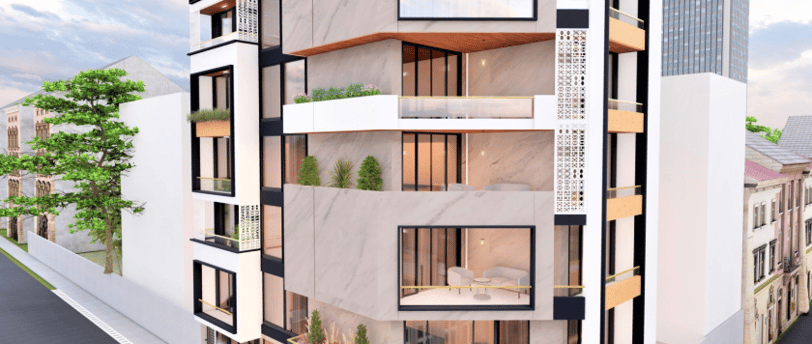The Importance of Quality Finishes in Construction


Understanding Quality Finishes
Quality finishes in construction refer to the final touches applied to a building's surfaces, including walls, floors, ceilings, and other architectural elements. These finishes extend beyond mere aesthetics; they significantly contribute to the overall functionality and longevity of a property. A well-executed finish not only enhances the visual appeal of a space but also serves as a protective layer that improves its durability against wear and tear, moisture, and environmental factors.
The aesthetic impact of quality finishes cannot be overstated. They set the tone for the overall interior and exterior design, influencing the perception of the property. For example, high-quality paint, well-laid flooring, and meticulously installed fixtures establish an impression of professionalism and attention to detail. Moreover, the right finishes can add value to a property, making it more appealing to prospective buyers and increasing its market worth.
In terms of functionality, quality finishes play a crucial role in enhancing a building's usability. Surfaces that are smooth and well-maintained are easier to clean and maintain, thus improving the hygiene and safety standards of the environment. Additionally, certain finishes can provide insulation or soundproofing, contributing to the comfort of the occupants. The durability of quality finishes also means less frequent repairs and maintenance, which can translate into cost savings over time.
Common types of finishes in construction include paint, plaster, wood, tile, and various types of wall coverings. Each of these finishes offers unique benefits and can be selected based on specific needs and preferences. The process of choosing the right finish should involve careful consideration of the material’s properties, the intended use of the space, and the overall design theme. By prioritizing quality in finishes, construction professionals create spaces that are both beautiful and resilient.
The Role of Paint in Construction Finishes
Paint plays a crucial role in construction finishes, serving not only aesthetic purposes but also functional ones. The choice of paint is significant in enhancing the visual appeal of a property, influencing how surfaces are perceived. Different surfaces—be it drywall, wood, or metal—require specific types of paint that are designed to adhere properly while providing a uniform finish. Choosing the right paint ensures longevity and durability, making it essential to consider not just the color but the finish type, such as matte, satin, or gloss, which can dramatically alter the appearance and feel of a space.
Color selection is another critical aspect of paint in construction. Colors can evoke specific feelings or create atmospheres; for instance, lighter tones can make spaces feel larger and more open, while darker hues can add sophistication and warmth. Additionally, texture plays a significant role in perception; varying finishes and techniques can contribute to a unique character for each property. Developers and homeowners alike should understand how paint color and texture influence the overall design scheme to maximize the impact of their spaces.
Beyond aesthetics, quality paint serves as a protective barrier against environmental damage. A high-quality paint formulation can resist fading, mildew, and peeling, essential for maintaining an immaculate appearance over time. By investing in premium paint, property owners can protect surfaces from harsh weather elements, ensuring structural integrity and minimizing maintenance costs. Ultimately, the quality of paint not only enhances the property’s longevity but also positively impacts its overall value. A well-maintained exterior, highlighted by quality finishes, is likely to attract higher market interest, confirming the importance of quality paint in construction finishes.
Tiling: A Foundation of Quality Finishes
Tiling serves as a fundamental component in achieving high-quality finishes in construction projects. The selection of the right tiles can significantly impact the overall aesthetic, durability, and maintenance of not only floors but also walls and countertops. Various types of tiles are available, each suited for different applications. Ceramic tiles, known for their versatility and affordability, are frequently used in residential and commercial spaces. Porcelain tiles, on the other hand, offer superior density and water resistance, making them ideal for high-moisture areas such as bathrooms and kitchens. Natural stone tiles, including marble and granite, elevate elegance but may require more upkeep.
The benefits of utilizing high-quality tiles cannot be overstated. For instance, durable tiles can withstand heavy foot traffic and resist scratches, contributing to their longevity and cost-effectiveness. Additionally, aesthetically pleasing tiles can enhance the visual appeal of a space, creating a harmonious ambiance that reflects the desired style. Effective maintenance of high-grade tiles is simpler as well, with many options being resistant to staining and easy to clean.
Installation techniques play an essential role in achieving a lasting and attractive finish. Proper subfloor preparation, adequate adhesive application, and precise cutting are critical to ensuring that tiles remain secure and visually appealing. Moreover, the use of grout and sealants can prevent moisture penetration and mildew formation, which are common issues associated with poor tiling. In contrast, poor-quality tiling can lead to frequent repairs, diminished property value, and unsatisfactory aesthetics. As such, investing time and resources into high-quality tiles and skilled installation is paramount for any construction project aiming for excellence.
Ceilings: The Overlooked Finishing Element
Ceilings, often the last consideration in interior design, play a significant role in shaping the aesthetics and functionality of a space. These architectural elements contribute not only to the visual appeal but also to the overall experience within a room. Different ceiling types such as suspended, coffered, and vaulted can dramatically alter how a space feels and interacts with ambient sound. For instance, suspended ceilings are versatile and practical, often used in commercial spaces for their ease of maintenance and adaptability, while coffered ceilings add a sense of depth and sophistication, enhancing residential interiors.
The choice of ceiling type can also influence how light interacts within a room. Vaulted ceilings, characterized by their high, sloping structures, create an illusion of space and openness. This design encourages natural light distribution, making any area feel larger and more inviting. On the other hand, lower ceilings may provide a more intimate atmosphere but can feel enclosing if not designed thoughtfully. Hence, understanding the dynamics of ceiling design is crucial for optimizing the perception of space.
Moreover, quality materials in ceiling construction are essential for both aesthetics and functionality. Selecting high-grade finishes not only improves longevity but also enhances the overall acoustics of a room. Materials that absorb sound, like acoustic tiles or textured drywall, are valuable in environments such as offices or theaters, where sound quality is paramount. In contrast, smooth, reflective surfaces can elevate the brightness and visual interest in a living or dining area.
In conclusion, the importance of ceilings in interior finishes cannot be understated. They serve a dual purpose: enriching the visual appeal while providing functional benefits, thereby shaping the overall character of the space. A well-thought-out ceiling design, incorporating quality materials, can elevate any construction project to new heights of sophistication and practicality.
Fixtures: Adding Character and Functionality
Fixtures play a pivotal role in defining the character and functionality of any constructed space. Whether in residential or commercial settings, high-quality fixtures—such as lighting, faucets, and hardware—enhance both aesthetic appeal and practical utility. The choice of fixtures can directly impact the atmosphere of a room. For instance, well-chosen lighting fixtures can create an inviting ambiance, while faucets that feature sleek designs can contribute to an overall modern aesthetic. Therefore, incorporating quality fixtures is essential in the construction finishes process.
Moreover, the style and quality of fixtures can significantly influence a property's overall value. Buyers often assess a property not only on its structural integrity but also on the quality of its finishes, including fixtures. Investing in high-quality and stylish fixtures can elevate the perception of a space, making it more attractive to potential buyers. Fixtures that are not only functional but visually appealing tend to resonate well in the market, thereby enhancing property value. For instance, contemporary lighting fixtures or designer faucets can serve as focal points, turning ordinary spaces into extraordinary ones.
Selecting the right fixtures requires careful consideration of the overall design goals of the project. It is crucial to choose fixtures that complement the architectural style and color palette of the space. Practicality should also be taken into account; for example, selecting durable faucets that can withstand daily use without compromising on style is essential. Additionally, energy-efficient lighting options can contribute to sustainability initiatives, providing both functional and eco-friendly benefits. Ultimately, by prioritizing quality fixtures, one can ensure that the finished construction not only meets functional needs but also reflects a sophisticated aesthetic.
The Financial Impact of Quality Finishes
The quality of finishes utilized in construction plays a pivotal role in determining the overall financial trajectory of a property. High-quality materials and finishes can significantly affect both the initial investment and the long-term return on investment (ROI). Investors and homeowners alike have increasingly recognized that superior finishes not only enhance aesthetic appeal but also contribute to the durability and functionality of the property.
One of the most compelling arguments for investing in quality finishes is their ability to elevate market appeal. Prospective buyers are often willing to pay a premium for properties that exhibit superior craftsmanship and materials. For example, updated kitchens with high-end countertops and fixtures can substantially increase a home's resale value. Studies have shown that certain renovations featuring premium finishes can yield returns as high as 80%. This addition to the property’s value is critical in competitive real estate markets where buyers have a plethora of options.
Furthermore, quality finishes often lead to long-term savings due to their durability and lower maintenance requirements. Properties constructed with top-grade materials tend to incur fewer costs related to repairs and replacements over time. For instance, high-quality flooring, when properly maintained, may last significantly longer than cheaper alternatives, thereby reducing the need for early replacement. This durability translates into financial savings and less disruption to daily life, making it a fiscally sound decision. Incorporating quality finishes into construction not only adds immediate value but also contributes to sustained financial advantage in the years ahead.
Investing in quality finishes thus emerges as a prudent strategy for both homeowners and investors. By enhancing a property’s market appeal and ensuring lower long-term maintenance costs, the financial implications can be notably positive. It is evident that the significance of quality finishes in construction extends beyond aesthetic appeal, reverberating profoundly in fiscal outcomes.
Conclusion: Investing in Quality Finishes
In the realm of construction, the emphasis on quality finishes cannot be overstated. Quality finishes play a crucial role in defining the overall aesthetics and functionality of a space. They not only elevate the visual appeal of a property but also enhance its durability and longevity. By investing in superior finishes, property owners can ensure that their buildings not only meet current standards but also withstand the test of time, providing long-term value.
When undertaking construction or renovation projects, it is essential for builders and owners to prioritize quality at every step of the process. Selecting high-grade materials and skilled professionals can yield significant benefits, including increased property value and reduced maintenance costs over the years. It is advisable to assess the long-term implications of finishing choices, as opting for lower-quality options may lead to frequent repairs, replacements, and diminished satisfaction with the space.
To make informed decisions, property owners should consider several actionable steps. Firstly, conducting thorough research on various finishing materials can help distinguish real quality from mere marketing claims. Furthermore, consulting with experienced architects, interior designers, or construction professionals can provide valuable insights into the best choices suited for specific projects. Seeking expert advice can also facilitate the identification of sustainable and energy-efficient finishes, which can minimize environmental impact while enhancing the quality of living or working spaces.
In conclusion, the importance of quality finishes in construction extends beyond mere aesthetics; it encompasses functionality, durability, and value retention. By committing to high-quality finishes and leveraging professional expertise, property owners and builders can ensure that their investments result in satisfying, beautiful, and enduring spaces. Quality finishes are not just an expense; they are a strategic choice for the future. A focus on quality is an investment that pays dividends in comfort, pride, and overall satisfaction in the long run.


